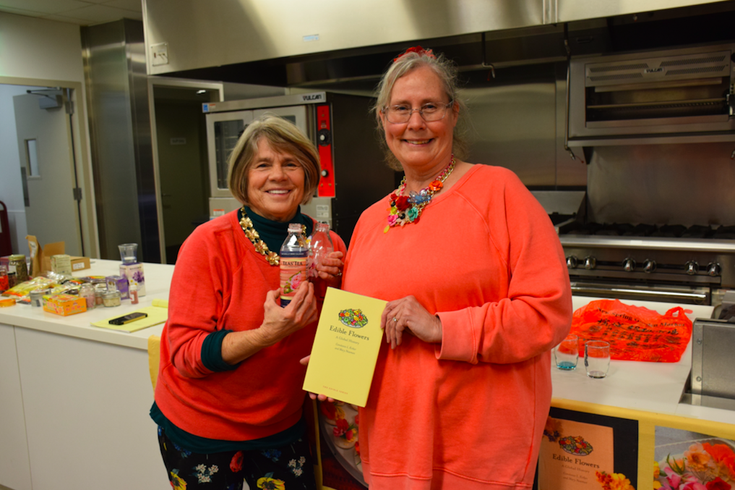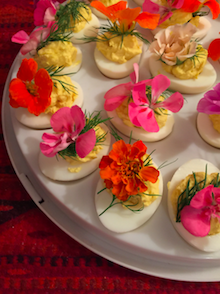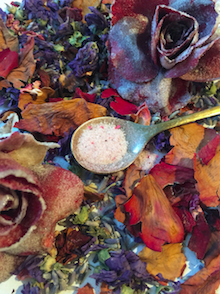
March 23, 2017
 Wendy Ramunno/for PhillyVoice
Wendy Ramunno/for PhillyVoice
Constance L. Kirker and Mary Newman, sisters and co-authors of "Edible Flowers: A Global History," pose with their book at the Free Library of Philadelphia on Monday, March 20, 2017.
No spring table is complete without a vase full of vibrant blooms, but incorporating edible flowers into your food and drinks can give an even more dramatic effect with minimal effort.
This past Monday, Constance L. Kirker and Mary Newman, sisters and co-authors of Edible Flowers: A Global History, discussed their book and hosted a demo of floral teas and sugars at the Free Library’s Culinary Literacy Center. Here are some of their best tips:
Fresh flowers
“It doesn’t take much to be an amazing hostess when you use edible flowers,” said Kirker, a Philadelphia-based art historian. One of her go-to uses is to top deviled eggs with nasturtiums and marigolds, transforming an ordinary dish into stunning hors d’oeuvres. Strewing flowers on a cheese plate, tossing them with salad greens, or using them to garnish a soup, entrée or dessert also adds a serious wow factor.
A floral garnish is a small touch but one that guests really appreciate. As Kirker and Newman traveled around the globe researching their book, they found that fresh flowers are universally presented with intent and purpose – to signal something special.
“Flowers are used in food by someone who cares about you, and who cares about the beauty of what you are about to eat,” they write.
“The presentation of flowers to someone almost always guarantees a Duchenne smile—a facial expression of genuine pleasure.”
Perhaps the most difficult part of cooking with fresh flowers is figuring out which types to use and sourcing them. Newman, who lives in Cincinnati and has a Ph.D. in toxicology, says that many people are worried about whether a particular plant is poisonous. Her advice to them is “just Google it.” A simple search will alert you to any concerns.
Newman doesn’t keep a list of inedible plants because there’s so much ambiguity after factoring in potential allergies and the medicinal properties of different species. However, one important rule of thumb is to never eat flowers sprayed with pesticides, such as those from most florists.
Edible flowers
Happily, even if you don’t have the time to join a local foragers group, you can still find edible flowers for your next dinner party. Whole Foods and Iovine Brothers usually have them in stock. DiBruno Bros, Philadelphia Wholesale Produce Market and Fair Food Farmstand can order them if you let them know in advance. A more cost-effective approach is to plant easy-to-grow nasturtiums in your garden, or let your herbs “bolt” (bloom prematurely) and snip off the flowers.
Dried flowers for tisanes & sugars
Because they have a much longer shelf life than fresh blooms, dried flowers—such as lavender, rose, violet, hibiscus, chrysanthemum, honeysuckle and jasmine—are a practical and economical addition to your pantry. Kirker and Newman suggest exploring markets that have a wide selection, such as Penn Herb Co. and Chinatown shops. After you determine what you like best, make your own custom blends in tea bags.
Note that although floral infusions are very similar to tea, they are called tisanes because they don’t contain the tea plant.
Butterfly pea flower, a key ingredient in the blue cocktail trend also makes for an eye-catching nonalcoholic tisane.
Flower hotpot
Like tisanes, floral sugars are simple to make and the variations are endless. To make a rose sugar, for example, combine white sugar, rose powder and dried rose petals and blend thoroughly. Store it in a jar in your cabinet and use it whenever you want to add a festive touch to baked goods.
For a quick and easy spring dessert, Kirker and Newman suggest topping boxed shortbread cookies with canned frosting and sprinkling them with your homemade floral sugar. Or roll cookie dough in the floral sugar before baking.
Cocktails & other beverages
Fresh flowers naturally make gorgeous garnishes for cocktails, but you can also freeze them in ice cubes or in an ice ring for a bridal shower punch.
Edible flowers
In addition to the iconic elderflower liqueur St. Germain, Kirker and Newman recommend botanical waters to add a spring element to your cocktails.
With the rise in soda alternatives on grocery and drugstore shelves, there’s now a wide range of festive floral beverages to choose from. Try DRY sparkling lavender water and locally brewed Baba’s Flower Power Kombucha. Or keep a bottle of Ikea’s elderflower syrup on hand to add to sparkling water or lemonade—kids love it.
 Constance Kirker /for PhillyVoice
Constance Kirker /for PhillyVoice Constance Kirker /for PhillyVoice
Constance Kirker /for PhillyVoice Constance Kirker /for PhillyVoice
Constance Kirker /for PhillyVoice